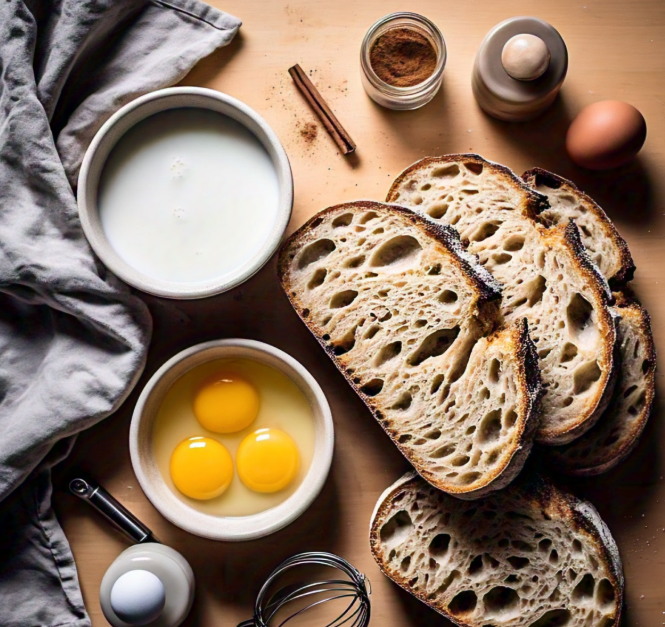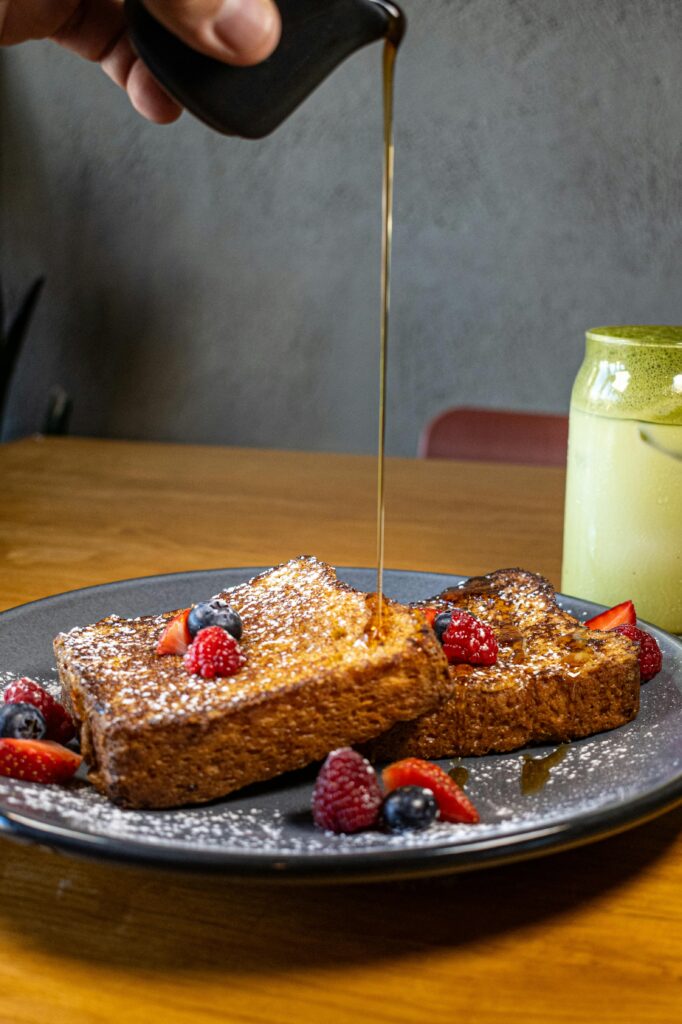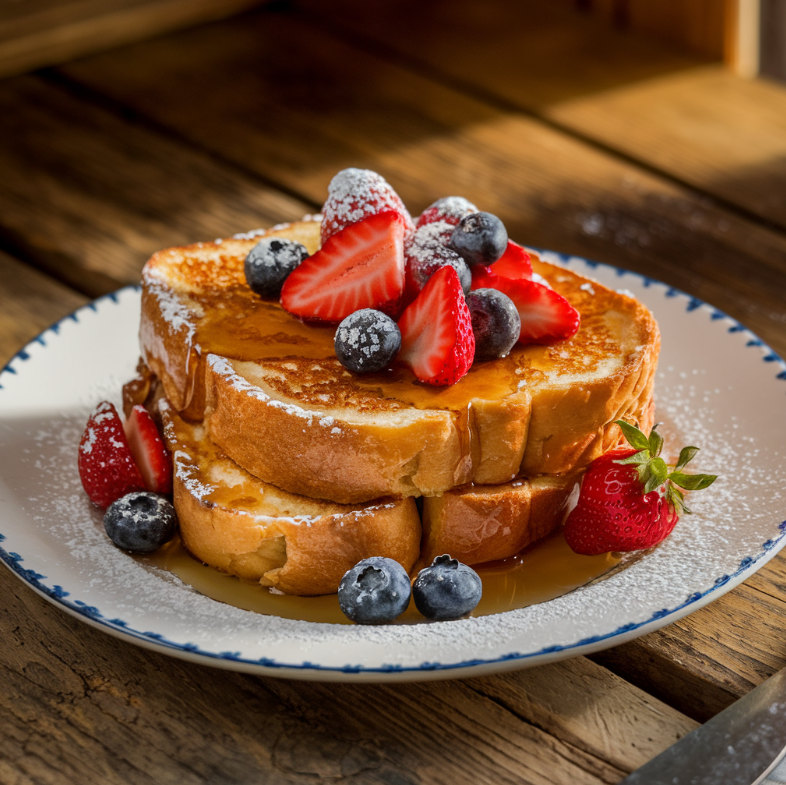There’s something magical about a plate of sourdough French toast. The crispy edges, fluffy center, and slightly tangy flavor make it a breakfast that feels fancy but is oh-so-easy to make. Whether you’re a brunch enthusiast or someone looking to spice up their breakfast game, sourdough French toast is the answer to your cravings.
But why sourdough? What sets it apart from regular bread? And how do you get it just right? We’re diving into everything you need to know, from tips and tricks to troubleshooting common mistakes. Ready to transform your mornings? Let’s get started! 🍞✨
The Allure of Sourdough French Toast
French toast isn’t new, but using sourdough bread adds a unique twist that elevates this dish to gourmet levels. Sourdough French toast brings together the tangy flavor of the bread and the rich, creamy batter for a match made in culinary heaven.
Why Sourdough is Perfect for French Toast
Unlike other breads, sourdough has a dense yet airy texture that soaks up batter like a sponge without falling apart. Plus, the natural tanginess balances the sweetness of toppings like syrup or powdered sugar.
Understanding the Unique Flavor of Sourdough Bread
Sourdough is made through fermentation, which creates its signature tangy taste. This natural process also develops a chewy crust and soft interior, ideal for holding up against creamy, eggy batters. If you’re wondering why your French toast with plain white bread feels one-dimensional, sourdough is the secret ingredient you didn’t know you needed.
The Science Behind Sourdough’s Texture and Absorption
The porous structure of sourdough allows it to absorb the batter deeply, ensuring every bite is infused with flavor. But it’s not just about science—it’s about experience. The slight chewiness of sourdough provides a contrast that’s downright delightful.
“Sourdough is like the bread version of a sponge. It soaks up the good stuff without ever losing its form—it’s practically magic!”
Ingredients for the Perfect Sourdough French Toast

The magic of this dish lies in its simplicity. You don’t need exotic ingredients or complicated techniques. Just a few pantry staples, and you’re on your way to French toast bliss.
Choosing the Best Sourdough Bread
Not all sourdough is created equal. Look for a loaf that’s a few days old—stale bread actually works better because it soaks up the batter without becoming mushy. If your bread is fresh, don’t worry! You can leave slices out overnight or lightly toast them before using.
Essential Ingredients and Substitutions
Here’s what you’ll need:
- Sourdough bread: Preferably thick-sliced.
- Eggs: Acts as the base of your batter.
- Milk or cream: Adds richness and helps bind the ingredients.
- Vanilla extract: A splash for sweetness and aroma.
- Cinnamon and nutmeg: Optional, but these spices add warmth and depth.
- Butter or oil: For cooking—nothing beats the flavor of butter sizzling on a pan.
Want to switch it up? Almond milk works as a dairy-free alternative, and maple extract can replace vanilla if you’re out of it.
Step-by-Step Guide to Making Sourdough French Toast
It’s time to get into the nitty-gritty. Let’s turn that loaf of sourdough sitting on your counter into the breakfast of your dreams.
Preparing the Batter: Tips and Tricks
The batter is the backbone of your French toast. Whisk eggs, milk, vanilla, and spices in a shallow bowl or dish. The key here is achieving a smooth consistency. Nobody wants scrambled eggs stuck to their toast, right? Whisk vigorously until everything is well combined.
Pro Tip: Add a pinch of salt to the batter. It enhances the flavors and balances the sweetness.
Soaking Sourdough Bread the Right Way
Lay your sourdough slices in the batter, letting them soak for about 20-30 seconds per side. Too short, and the bread won’t absorb enough; too long, and it might fall apart. The goal is to have the bread saturated but still sturdy enough to transfer to the pan.
“Think of the bread as a sponge—it needs enough batter to soak up the flavor, but you don’t want it to collapse under pressure.”
Cooking to Golden Perfection
Heat a non-stick skillet or griddle over medium heat. Melt a generous pat of butter, ensuring the pan is well-coated. Place your soaked bread slices onto the pan, leaving space between each piece.
Cook for 2-3 minutes per side, flipping once. You’re aiming for a golden-brown exterior with a slightly crisp texture. Keep an eye out—burnt French toast can sneak up on you if you’re not careful!
Enhancing the Flavor: Toppings and Pairings
Now that your sourdough French toast is golden and ready, it’s time to jazz it up with toppings that turn a simple breakfast into a masterpiece. The best part? The possibilities are endless. You can go classic, indulgent, or even healthy, depending on your mood (or what’s in your pantry).
Classic Toppings for Sourdough French Toast
Sometimes, less is more. These timeless options highlight the natural flavors of sourdough French toast without overpowering it:
- Maple Syrup: The sweet, sticky goodness that’s practically French toast’s best friend.
- Powdered Sugar: A light dusting adds elegance and sweetness.
- Fresh Fruits: Think berries, bananas, or even thinly sliced apples for a refreshing twist.
- Serve with toppings like syrup, powdered sugar, or even a side of blueberry cheesecake for a tangy-sweet pairing.
“When in doubt, let the classics shine. A drizzle of syrup and a sprinkle of powdered sugar can work wonders.”
Creative and Gourmet Pairing Ideas
Feeling adventurous? Take your French toast to the next level with these gourmet-inspired toppings:
- Whipped Cream and Nutmeg: Perfect for a brunch gathering, this adds a touch of luxury.
- Caramelized Bananas: Sauté banana slices in butter and brown sugar for a sweet, sticky topping.
- Savory Spin: Yes, you can go savory! Top with crispy bacon, fried eggs, or even avocado slices for a breakfast twist.
- Nut Butter Drizzle: Almond, peanut, or cashew butter adds a protein-packed punch and creamy texture.
And don’t forget about presentation—arranging toppings with care makes your dish look as good as it tastes. 🍓🍯
Common Problems When Making Sourdough French Toast
Even seasoned cooks run into hiccups. Don’t worry, we’ve got solutions for the most common French toast dilemmas.
Why Is My French Toast Soggy?
Soggy French toast is a letdown, but the fix is simple:
- Use stale bread: Fresh bread absorbs batter unevenly, leading to mushy results.
- Don’t oversoak: A quick dip in the batter is all you need; don’t let the bread linger too long.
- Cook on medium heat: Too low, and the bread stays wet inside; too high, and it burns on the outside before cooking through.
Preventing Burnt or Undercooked Toast
Burnt toast? That’s just sad. Undercooked? Not great either. Here’s how to find the sweet spot:
- Even Heat Distribution: Use a well-seasoned cast-iron skillet or non-stick pan for consistent results.
- Monitor Your Butter: Melted butter can brown quickly. Add it in small amounts as you cook to prevent scorching.
Healthy Variations of Sourdough French Toast
Who says indulgence can’t be nutritious? With a few tweaks, you can enjoy sourdough French toast guilt-free.
Using Whole Grain Sourdough for a Nutritious Twist
Whole grain sourdough offers extra fiber, nutrients, and a nuttier flavor. It’s slightly denser than white sourdough, so be sure to adjust soaking times to ensure proper absorption. Pair it with fresh fruit and a drizzle of honey for a wholesome start to your day.
Dairy-Free and Vegan Alternatives
Need to skip the dairy or eggs? No problem!
- Milk Substitutes: Almond, oat, or soy milk work beautifully in the batter.
- Egg Replacements: Flaxseed meal mixed with water (1 tbsp flaxseed to 2.5 tbsp water) makes a great vegan binder.
- Vegan Butter or Oil: Coconut oil or plant-based spreads are perfect for cooking.
By combining these alternatives, you can create a plant-based version of sourdough French toast that’s just as delicious as the original. 🌱
The History and Tradition of French Toast

Did you know French toast isn’t actually French? It’s a dish with deep historical roots that spans cultures and continents. Let’s take a step back in time.
How French Toast Became a Breakfast Staple
French toast traces its origins to ancient Rome, where it was known as pan dulcis. Cooks would soak bread in milk and eggs before frying it—sound familiar? Over centuries, the recipe evolved, eventually finding a home in French cuisine under the name pain perdu, or “lost bread,” referring to the practice of using stale bread.
“French toast has been a thrifty, delicious way to breathe new life into old bread for centuries. Talk about timeless appeal!”
The Role of Sourdough in French Cuisine
Sourdough’s roots run deep in European culinary history, particularly in France, where naturally fermented bread has been a staple for centuries. Incorporating sourdough into French toast is not just delicious but also a nod to tradition.
Perfect Beverages to Serve with Sourdough French Toast
Pairing your sourdough French toast with the right beverage can elevate the entire meal experience.
Coffee and Tea Pairings
- Rich Coffee Blends: A bold cup of coffee complements the sweetness of French toast, especially when served with maple syrup or caramelized toppings.
- Earl Grey Tea: The citrus notes in Earl Grey balance the tanginess of sourdough beautifully.
Fresh Juices and Smoothies That Complement the Dish
If you prefer something refreshing, try these options:
- Fresh Orange Juice: A classic that cuts through the richness of the dish.
- Berry Smoothies: Packed with antioxidants and bursting with flavor, smoothies make an excellent sidekick to your French toast.
Storing and Reheating Sourdough French Toast
Leftovers? Lucky you! Sourdough French toast can be just as delicious the next day if stored and reheated properly. Here’s how to keep that flavor and texture intact.
Best Practices for Refrigeration and Freezing
If you’re planning to enjoy your leftovers within a few days:
- Refrigeration: Place your French toast slices in an airtight container. They’ll stay fresh for up to 3 days in the fridge.
- Freezing: For longer storage, wrap each slice individually in plastic wrap or aluminum foil, then store them in a freezer-safe bag. They’ll last up to 3 months.
Quick Tip: Place parchment paper between slices before freezing to prevent them from sticking together.
How to Reheat Without Losing Flavor or Texture
Reheating French toast can be tricky—nobody wants soggy or overly dry slices. Here are a few foolproof methods:
- Oven: Preheat your oven to 350°F (175°C). Place slices on a baking sheet and heat for 8–10 minutes, flipping halfway through.
- Toaster: For crispy edges, pop the slices into a toaster. Be mindful of your toaster’s settings to avoid burning.
- Stovetop: Heat a skillet over medium heat, add a small amount of butter, and warm the slices for about 2 minutes per side.
Avoid using the microwave unless you’re in a hurry—it tends to make French toast rubbery.
“Reheated French toast is like a second chance at breakfast perfection. Just don’t rush the process, and it’ll taste as good as new.”
Fun Variations and International Twists on Sourdough French Toast
French toast is a canvas, and sourdough adds a gourmet touch. But why stop there? Experimenting with flavors and styles can take your breakfast game to a whole new level.
Sourdough French Toast Casserole
Transform your French toast into a crowd-pleasing casserole:
- Cut sourdough into cubes and place them in a greased baking dish.
- Pour a spiced custard mixture over the bread.
- Top with brown sugar, cinnamon, and a few pats of butter.
- Bake at 375°F (190°C) for 30–40 minutes until golden and bubbly.
Perfect for holiday mornings or family brunches, this variation serves everyone without requiring you to stand at the stove flipping slices.
Global Takes on French Toast with Sourdough
Why not draw inspiration from around the world?
- Pain Perdu (France): Add a splash of orange liqueur or orange zest to your batter for a French twist.
- Torrijas (Spain): Soak the bread in sweetened wine or honey before frying for a decadent Spanish version.
- Hong Kong-Style French Toast: Sandwich peanut butter between two slices of sourdough before dipping and frying. Top with condensed milk for a sweet finish.
Frequently Asked Questions About Sourdough French Toast
If you’ve still got questions, don’t worry. Here are some answers to common queries that might pop up when making sourdough French toast.
Can I Use Fresh Sourdough Bread?
Yes, but be cautious. Fresh sourdough bread can be too soft and may fall apart when soaked in batter. If fresh bread is all you have, lightly toast it beforehand to firm it up.
What Are the Best Spices for French Toast Batter?
Cinnamon is a classic, but you can get creative! Nutmeg, cardamom, or even a pinch of cloves can add depth and warmth to your batter.
Is Sourdough Healthier Than Regular Bread for French Toast?
Sourdough is often considered healthier because of its fermentation process, which can improve digestibility and nutrient absorption. Using whole-grain sourdough increases fiber content, making it a nutritious choice.
How Do I Prevent My French Toast from Sticking to the Pan?
Use a non-stick skillet or a well-seasoned cast iron pan, and always heat your butter or oil before adding the soaked bread. This creates a barrier between the bread and the pan, preventing sticking.
Can I Make Sourdough French Toast Ahead of Time?
Absolutely! You can prepare and refrigerate the batter and sliced bread separately the night before. In the morning, just soak and cook. Alternatively, freeze cooked French toast and reheat as needed.
What’s the Best Way to Serve Sourdough French Toast for a Crowd?
Opt for a casserole or bake the slices on a sheet pan in the oven. This way, you can prepare multiple servings at once without hovering over the stove.
Conclusion: A Breakfast Worth Savoring
Sourdough French toast isn’t just a meal; it’s an experience. The tangy, chewy bread paired with creamy batter and customizable toppings creates a dish that feels indulgent yet approachable. Whether you’re cooking for yourself, your family, or a brunch crowd, this recipe is bound to impress.
So, grab that loaf of sourdough sitting on your counter and turn it into something extraordinary. With a little creativity and the tips from this guide, you’ll be crafting sourdough French toast so good, it might just become a weekend tradition. 🍴
If you’re a fan of experimenting in the kitchen, try adding a dollop of whipped cream or crushed cookies, inspired by our guide to how to assemble a brookie. These playful elements can transform your dish into a dessert-like masterpiece.

